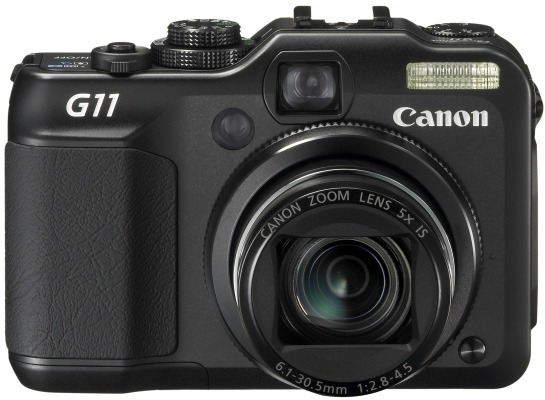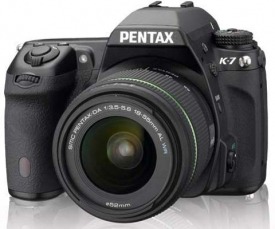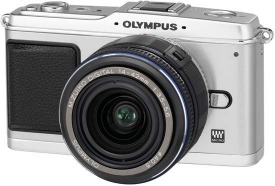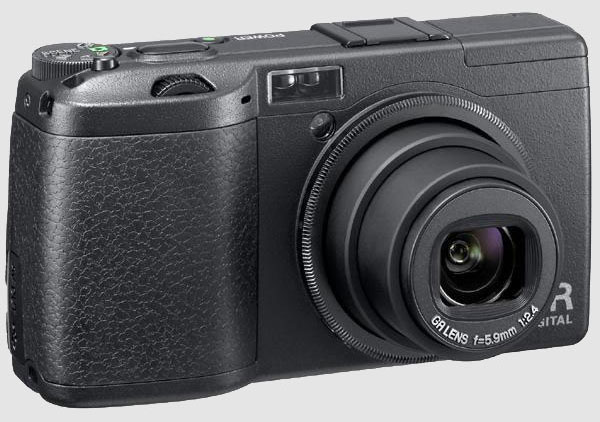A new acquisition
16th January 2010Back in the early days of this blog, I mulled over the idea of having a high-end digital compact camera to complement a DSLR that then was delivering very dusty images; that Canon EOS 10D was cleaned since then and comes in for occasional use to this day. That was nearly three years ago and a first generation Ricoh GR Digital was the item that then was catching my eye. At the time, I failed to justify spending that much money on such a thing and ended up acquiring a new Pentax K10D DSLR instead. The question that rattled about my head was this: what was the point of spending DSLR money on a compact camera? Its one that never really went away and comes to mind when you see the prices of interchangeable lens compacts like Olympus’ Pen and equivalent offerings from Panasonic and Ricoh (there, it’s interchangeable lens units rather than actual lenses).
The strongest counterpoint to the cost conundrum is the little matter of size. SLR (film or digital) cameras are sizeable things and there is a place for having something that drops into a pocket. It is that which has propelled me into taking delivery of a Canon PowerShot G11. It may need a good-sized pocket but, unless you are going out with no jacket, it shouldn’t be a problem most of the time. For those shorter sorties when I don’t fancy bringing an SLR out, it well-built and looks the business though some acclimatisation is in order to make the best of the knobs, buttons and menus. Nevertheless, the included manual will help with this process (there’s a paper quick start guide and more detailed documentation on CD).

The camera hasn’t seen extensive use just yet so here are a few early impressions. Firstly, there’s the matter of size: it’s even smaller than the first camera that I ever bought (more than fifteen years ago) and that was a Ricoh 35 mm compact film camera. That comparison is even more striking when you consider the feature sets. The Ricoh was a fixed 35 mm lens affair with things like date and time stamping, ISO choice and a nod towards scenic mode selection. In contrast, the much newer Canon is loaded with the sorts of things that normally are found almost exclusively on SLR’s, starting with its effective 28-140 mm focal length range.
Exposure modes such as manual, aperture priority and shutter priority complement scene-based modes and another for movies (not a concern of mine, it has to be said). As if that weren’t enough, there’s exposure compensation too. It came as a surprise to me to find a form of manual focussing included though it is not as convenient as turning a focussing ring on a lens. You can see the inbuilt flash above but there’s also a hotshoe and a place to attach a tripod too. Settings like white balance and file format are accessed using the Function/Set button with the lever underneath the shutter release button controlling the focal length of the lens. In addition, there’s also image stabilisation and that’s important when you’re using live view to compose a photo. Spot metering and focal point selection are other things that find their way into the package. Some may be excited by other things but exposure and focussing are essential for any photographic efforts.
An optical viewfinder is included and it has dioptre settings too but my first impressions are that live view though the rear screen trumps it and I see no need for such things on SLR’s. That also flips out from the camera body and can be rotated either for self-portraiture or for folding back in on the camera body for use like a non-articulated screen. Another use is with those occasions when the subject means holding the camera in positions that would be impossible with a conventional screen; holding the camera over your head or down low on the ground are the sorts of situations that come to mind.
Of course, there’s more there than those features that I have listed and the specifications on the Canon website are as good a place to start as any. So far, my only testing has been of the cursory checks variety and to make sure that the thing works properly. Still, this has given me more of a feel for the camera and how it operates. As you’d expect, high ISO settings are noisy but a bigger surprise was that the smallest aperture setting is f/8. Being used to SLR’s, I was expecting to get f/16 and its like on there but a spot of internet investigation showed that I should have been taking the size of the sensor into account with my expectations. Any trials so far have been in dull weather so I’d need to use it in a wider variety of conditions before giving it the sort of wider appraisal that you’d find in the likes Outdoor Photography (who liked it, it has to be said). For what it’s worth, I have found no major criticism so far though I cannot see it usurping my SLR’s but that never was the intention anyway.
Temptations, temptations…
19th August 2009
The last time that I went out and bought a new camera was over two years ago and I am minded not to make another purchase for a while. Apart from damage to the battery cover arising from a fall, my Pentax K10D has survived so far without a problem and I admit to being satisfied with the photos that it makes. Following a professional sensor clean, my Canon EOS 10D has been pressed into service over the past few months too. In the meantime, 6 and 10 megapixel sensors generate nowhere near the attention that might have been case a few years back but that’s by the by. In fact, the megapixel race seems to have stalled with features like video being added to stills cameras over the last year and live screens coming to prominence also. Neither would make me rush out to buy a new DSLR anyway, perhaps because having things the old way suits me just fine and megapixel counts never ever moved me in the first place either.
That’s never to say that the likes of Pentax’s K-7 or Canon’s EOS 50D and 5D Mark II don’t capture my attention with their promises of better quality. However, with things the way that they are in the world, I am more likely to hold onto my cash or maybe invest in new photo processing software for making the most of what I already have. Ideas for photography projects creep into my head when I get to looking over my online photo gallery and realise that not have my tastes changed but my photographic eye has developed too. That seeing of things in a new light may mean that old subjects get revisited and I don’t need a new camera to do that.

High end compact cameras such as Canon’s G11 and Ricoh’s GR Digital III do detain attention for a while but a quick look at their prices proves that you really got to need the portability and I never can justify the outlay when a DSLR will do all that I want from it, and perhaps even for less money. While I admit to pondering the purchase of a GR Digital to cover for the EOS 10D while it was away for cleaning, the Pentax came to be acquired when I realised that the versatility of a DSLR was too much to lose, even for a while. Olympus’ E-P1 may have bridged the gap but the old question of going miniature for the price of a full sized article recurs.
All in all, I am going to stick with what I have right now. We are coming to a time of year when things appear more golden and that combination of lighting and colour are what really matters, not how many megapixels is in you camera sensor unless you are making large prints or supplying stock libraries. As long as my cameras continue to deliver pleasing results, I’ll stick with improving my skills and taking my time over that task, even with all the announcements of new cameras at various exhibitions and shows.
Camera tales
20th January 2007Anyone who has ever been on HennessyBlog will know that I enjoy walking in the countryside and that I always have a camera with me when I do. Like many digital SLR owners, I am beginning to see the tell-tale spots in my photos that are caused by a dirty sensor. And it isn’t that I am continually changing lenses either: I rarely remove the Sigma 18-50 mm DC zoom lens that I use with the camera. Rather than trusting myself with the cleaning (I have had a go already without much success), I am giving serious consideration to letting the professionals take care of my Canon EOS 10D, my only digital camera. I have already been quoted something of the order of £35 by a Canon service centre not far from me and am seriously considering taking them up on the offer.
Of course, sending it away to them means that I will have to forego the ability to include photos with posts on HennessyBlog describing my walks in the kind of timescale to which I have become accustomed; of course, this is where digital really scores. I will still have a camera with me as film remains my mainstay, even in this digital age. The camera in question is another Canon, an EOS 30 that I acquired used from Ffordes Photographic. While taking a recent peek at their website, I have just spied a used EOS 1V going for £399, a song for what remains Canon’s top of the range film SLR. Yes, I am tempted but I must stay real. In fact, I did not pay full price for my EOS 10D. That was part of the run-out stock that 7dayshop.com were selling off at next to half of the EOS 10D’s original asking price in the wake of its being superseded by the EOS 20D (itself since replaced by the EOS 30D: digital is a fast-moving world).
Sending a camera away for attention is not new to me as I also acquired a used Minolta X-700 manual focus SLR, again obtained from Ffordes, and that needed a spot of maintenance after a year in my possession. There was a problem with the shutter that cost me £75 to get Minolta to fix. Now that Minolta as a camera maker is no more, I was wondering who would attend to it in the future. That question was answered by a recent look on the web: in the UK it is JP Service Solutions, a division of Johnson’s Phototopia. Konica Minolta retain this information on their website. Konica Minolta’s failure to capitalise effectively on the digital revolution in its early days, particularly in the SLR area where they gifted their competitors a massive head start, cost them their future in the photographic business and now Sony continues the mantle, a sad end to one of camera manufacturing’s great innovators.
Returning to my digital-less dilemma, I suppose that I could get another digital for backup duty; I have to admit that a DSLR is a bulky contraption to be carrying in airline luggage. The camera that has made it onto my wish list is Ricoh’s GR Digital, a highly regarded offering that follows in the great tradition of its film forbears, the GR 1 and GR 21. Given that my first 35 mm camera was a Ricoh, and I have it still, this would be a case of returning to my roots. Of course, having it on a wish list is very different from having it on the to-do list and finances will certainly dictate if the purchase is made, though a finance deal offered by Warehouse Express does make it more accessible. Maybe some day…
